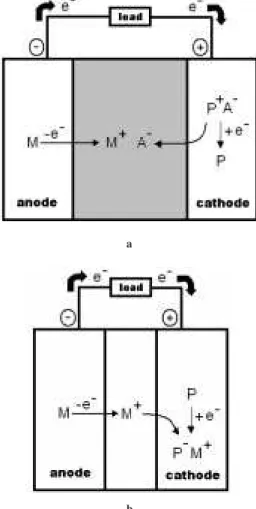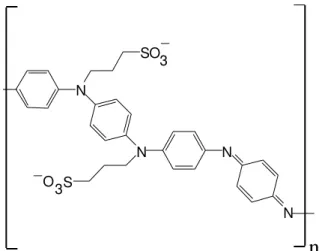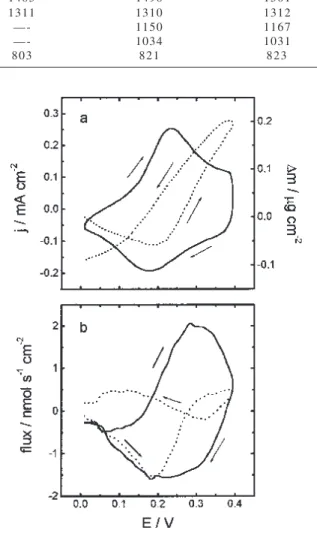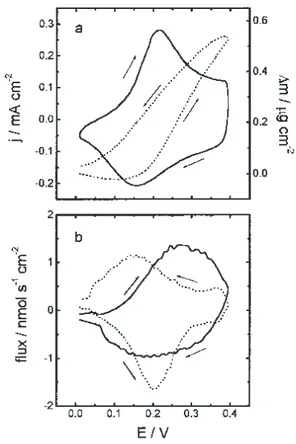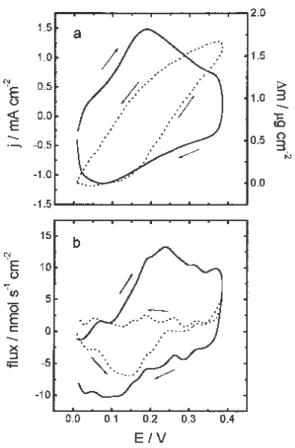Article
Study of Charge Compensation During the Redox Process of
Self-Doped Polyaniline in Aqueous Media
Hamilton Varelaa, Roberto M. Torresia* and Daniel A. Buttryb
a
Instituto de Química de São Carlos, Universidade de São Paulo, CP 780, 13560-970, São Carlos - SP, Brazil
b
Department of Chemistry, University of Wyoming, Laramie, Wyoming, 82071-3838, USA
Um dos problemas mais importantes associado à utilização da polianilina como material catódico em baterias recarregáveis de lítio está relacionado à degradação na densidade de energia devido à participação massiva de ânions durante o processo de compensação de cargas. Este trabalho descreve a síntese de uma polianilina auto-dopada, poli-(anilina-co-N-ácido propanossulfônico-anilina), e avalia suas propriedades em meio aquoso, considerando o aumento na participação de prótons no mecanismo de eletroneutralização. A caracterização foi feita utilizando análise elementar e espectroscopias no infravermelho e ultravioleta-visível. As propriedades eletroquímicas foram investigadas com a microbalança eletroquímica a cristal de quartzo e voltametria cíclica. Os resultados obtidos mostram que a participação de prótons no processo redox da poli-(anilina-co-N-ácido propanossulfônico-anilina) aumentou, em relação à polianilina.
One of the most important problems associated with use of polyaniline as a cathode material in rechargeable lithium batteries is related to energy density degradation due to the predomination of anion participation in the charge compensation process. This work describes the synthesis of a self-doped polyaniline, poly-(aniline-co-N-propanesulfonic acid-aniline), and evaluates its properties in aqueous acid solutions, with special attention to the increase of proton participation in the electroneutralization mechanism. The characterization was carried out using elemental analysis, FTIR and UV-vis spectroscopies. Electrochemical properties were investigated with the electrochemical quartz crystal microbalance and cyclic voltammetry. The results obtained show that proton participation was increased for the redox process of poly-(aniline-co- N-propanesulfonic-acid-aniline) in relation to polyaniline.
Keywords: poly (aniline-co-N-propanesulfonic acid-aniline), polyaniline, electrochemical crystal quartz microbalance, charge compensation process, ECQM.
Introduction
Polymers with π-conjugated bonds in the chain show uncommon properties like low energy electronic transitions, low ionization potential and high electron affinity. These prop-erties result in polymers that can be oxidized and reduced easily. In order to compensate the charge produced in the polymer matrix by such redox processes, there is usually in-corporation/expulsion of ionic species (dopants). Among conducting polymers, polyaniline (PANI) has a prominent role due to its potential applications in energy storage, electrochromic devices, chemical sensors and a series of other electrochemical devices1,2. PANI has also been evaluated for
use as cathode for rechargeable lithium batteries3.
The participation of ionic species in the insertion/expul-sion process and their influence on the charge compensa-tion mechanism needs to be investigated because this knowl-edge is of critical importance in the evaluation of PANI as a cathode material for secondary batteries. Ionic transport in the film, necessary to maintain its electroneutrality, has been thoroughly investigated in the case of aqueous solution4-7.
The main problem related with PANI as a cathode for a lithium battery is the majority participation of anions in the charge compensation process8. This fact produces a decrease in
the energy density, leading to a power capacity lower than 30 Wh kg-1 for the PANI-Li system9. It is obvious that an
increase in the energy density can be expected if the poly-mer uses only cations for the charge compensation process10. This conclusion is related to different types of
configuration for batteries using conducting polymers as
e-mail: Torresi@iqsc.sc.usp.br
cathode. Among the six different configurations for batter-ies with conducting polymer cathodes11, three of them are
based on the principle that the cathode uses the cation produced in the anode oxidation to compensate charge. This kind of configuration has the advantage that it does not use a great amount of excess supporting electrolyte so, thin electrolyte films can be used. As a consequence, a diminution in the mass and volume of the battery is ob-tained. This produces an increase in the specific properties of the battery. Figure 1 shows two different configurations. In Figure 1a, the polymer used as the cathode material might be a material such as PANI, for example, where anions play an important role in charge compensation process and the battery will require an electrolytic reservoir to store anions. In Figure 1b, a polymeric cathode is used where cations are responsible for neutralization process. In this case, the cath-ode can use the cations produced in the ancath-ode, and the described reservoir can be replaced by a thin membrane for cation transport.
It is very important to establish the nature of the ionic exchange and solvent participation in the redox process of conducting polymers in order to choose the best design of the battery, improving in this way their properties. Two alternatives to attempt an increase of the specific proper-ties of PANI for lithium batteries have been studied. First, derivatives obtained by the modification of the original
monomer; second, the composites like PANI/NAFION12
or PANI/DMcT13. In this work, the properties of self doped,
poly - (aniline - co - N - propanesulfonic acid - aniline), PAPSAH, were investigated in aqueous media by the use of electrochemical crystal quartz microbalance (ECQM) in conjunction with cyclic voltammetry (CV) experiments. In addition, the synthesis and characterization of PAPSAH are described. For comparison, electrochemically formed PANI films were also investigated. The main purpose is to obtain information about the influence of anionic group (propanesulfonic acid) linked to the polymer chain on the charge compensation process neutralizing the positive charge on the PANI chains.
Experimental
PAPSAH films were formed by solvent evaporation and PANI films were electrochemically deposited onto Au elec-trodes supported onto 6 MHz AT cut quartz crystals that were 26 mm in diameter. A platinum wire was used as counter electrode and all potentials are referred to the saturated calomel electrode (SCE). Both sides of the quartz crystals were coated with gold by vacuum deposition but only one of the faces was exposed to the electrolyte solution (active area of 0.2 cm2). The resonance frequency shift was
mea-sured with a HP-5370B Universal Time Counter and elec-trochemical measurements were performed with a FAC 2001 potentiostat/galvanostat.
The electrochemical polymerization of aniline was car-ried out by cycling the potential between -0.2V and 0.75V (versus SCE) at 50 mV/s in a solution of 1mol dm-3 HCl +
0.5M C6H5NH2. All resulting polyaniline films presented
good adherence and homogeneity. Films were grown until a net mass gain of 28 mg cm-2 was reached corresponding
to a film thickness of 55 nm, determined using a profilometer. After deposition, films were washed carefully with purified water. Electrodes were placed in a usual three-compartment electrochemical cell containing monomer free 1 mol dm-3
HCl or HClO4 aqueous solutions.
The method employed for the chemical synthesis of PANI was previously described by Huang et al14. An
aque-ous solution of (NH4)2S2O8 was added slowly to a
solu-tion of aniline dissolved in 1.0 mol dm-3 aqueous HCl at
5oC. After 1 h the precipitate which had formed was re-a
Figure 1. Different configurations for secondary batteries with eletronic conducting polymer as cathode. (a) Charge compensation process carried out by anions and (b) Charge compensation process carried out by cations. Adapted from reference 11.
moved by filtration, washed repeatedly with 1.0 mol dm-3
HCl and dried under dynamic vacuum for 48 h. The material thus obtained was identified as emeraldine hydrochloride. The emeraldine hydrochloride was converted into emeraldine base by stirring with 0.1 mol dm-3 solution of
NH4OH for several h. The material was dried under
dy-namic vacuum for 48 h. The lower molar mass species were extracted with CH3CN until the extract was colourless. The PANI (2.4 g) obtained, in the blue emeraldine base form reacted with an excess NaH (1.1 g) in dimethyl sulfoxide (DMSO), at 45oC under nitrogen atmosphere for 6 h. The
result was a black green solution, in which the original emeraldine base should have been converted to the deprotonated form of the emeraldine base. The resulting solu-tion was reacted with an excess of 1,3 - propanesulfone (4.25 g) for 20 h. at room temperature, yielding a black-blue solution. This solution was precipitated with 1 mol dm-3 HCl aqueous
solution, the green solid obtained (HCl doped PAPSAH) after filtration was washed with a large amount of acetonitrile and then undoped with NaOH aqueous solution to give a blue solution. This solution, after filtration, was purified by dialysis with semipermeable membrane (Sigma D - 9652, molar mass cutoff of 12,400 g mol-1) in purified water (Milli - Q, Millipore),
which was replaced with fresh water frequently during 2 days. The poly(aniline-co-sodium N-propanesulfonate-aniline, PAPSANa) aqueous solution obtained was concentrated in a vacuum evaporator (MA 120, Marconi) at a temperature be-low 50oC. The polymer PAPSANa was then converted to
poly(aniline-co-N-propanesulfonic acid-aniline, PAPSAH) shown in Figure 2, by exchanging Na+ for H+ in a H+-type
ion-exchange resin (Dowex 50WX4 - 100, Sigma) to give a PAPSAH green coloured aqueous solution (doped state). The modified electrode was obtained by casting this green solution onto the working electrode. The deposited mass was typically 30 µg cm-2.
Results and Discussion
PAPSAH characterization
The elemental analysis results are shown in Table 1. The S/N ratio obtained for PAPSAH was 0.55, close to 0.48 ob-served in previous results15, showing that about 50 % of
total nitrogen in the chains are linked to alkane sulfonic acid.
N
SO
N
S
N
N 3
_
3 O _
n
Figure 2. PAPSAH structure.Table 1. Elemental analysis results.
Element N C H S
Mass Percentual 5.86 44.78 4.23 7.41
Figure 3 shows the FTIR spectra for PANI and PAPSAH. The bands obtained are compared to litera-ture data16-19 in Table 2 showing that the present
re-sults agree with those obtained by others authors. The PAPSAH IR spectrum (Figure 3b) shows that the inten-sity ratio of the peaks at ~1585 cm-1 and ~1500 cm-1 is
a qualitative measurement of the oxidation state of the polymer and, in both cases, these ratios show the same oxidation state, indicating an oxidation level of ca 0.8. The presence of the absorption bands at 1150 and 1034 cm-1 for PAPSAH is characteristic of the asymmetric
and symmetric O=S=O stretching vibrations, respec-tively. Both polymers (Figures 3a and 3b) present ab-sorption bands at 826 and 821 cm-1, characteristic of
the C-H out-of-plane bending vibrations of 1,4 - disub-stituted benzene rings. This shows that the reactions used to produce PAPSAH do not lead to ring substitu-tion at other posisubstitu-tions. The characteristic band of the secondary aryl amine bending mode (1310 cm-1)
con-firms that the alkanesulfonic acid groups are linked to the amine nitrogens.
Figure 4 shows UV-vis spectra for PAPSAH aqueous solutions in base and acid forms. The insulator/conductor transition can be discussed in terms of polaron bands, re-lated to base/acid form. The bands located at 400 and 860 nm (3,10 and 1.44 eV) are attributed to polaron/bipolaron appearance, and the disappearance of 570 nm (2.17 eV) band is related to quinoid rings10. These results suggest that
when PAPSAH is converted from the base to the acid form, there is a strong electronic delocalization, leading to an increase in the mobility of charge carriers.
Redox process (Figure 5a) shows the j/E and ∆m/E potentiodynamic profiles of PAPSAH in HCl electrolytic solution at 50 mV s-1. It can be seen that at the beginning of
process is mainly carried out by proton expulsion, while the incorporation of chloride anions becomes more impor-tant at more positive potentials. During the reduction pro-cess a mass diminution is observed as a consequence of chloride anion expulsion and proton incorporation.
In order to analyze the EQCM results in a quantitative form, it is possible to write the global mass change caused by participation of protons, anions and solvent molecules as:
∆m( )E =WH+ξH+( )E +WA−ξA−( )E +WS S Eξ( ) (1)
where W is the molar mass of protons (H+), anions (A- ) or
solvent molecules (s) and ξ is the number of moles of of protons, anions or solvent molecules. Considering electroneutralization conditions, the charge involved in the redox process as a function of the number of moles of ionic species can be written as
q( )E = −FξH+( )E +FξA−( )E (2)
where F is the Faraday constant. The charge for protons
Table 2. Characteristic bands observed in the FTIR spectrum.
Characteristic band Pani / cm-1 PAPSAH / cm-1
Exptl. Literature15,16 Exptl. Literature15,16
C=C quinoid streching 1583 1582 1583 1592
C=C benzenoid streching 1491 1485 1498 1501
C-N secondary aryl amine bending 1300 1311 1310 1312
O=S=O asymmetric streching — - — - 1150 1167
O=S=O symmetric streching — - — - 1034 1031
C-H out-of-plane bending 826 803 821 823
Figure 3. FTIR spectra. (a) PANI and (b) PAPSAH.
Figure 4. UV-vis spectra for PAPSAH in acid (________) and base (…………..) forms.
and anions was considered 1 and -1, respectively. Combin-ing equations 1 and 2, the contribution of anions, xA can be calculated together with solvent participation as a func-tion of potential
ξA E S ξ
HA S E E HA H HA E W W m W W W q F − + + = + ( ) ( ) ( ) ( ) ∆ (3)
In the same way, can be obtained for the protons,
ξH E S ξ
HA
S E E
HA A HA E W W m W W W q F + − + = − ( ) ( ) ( ) ( ) ∆ (4)
where HA corresponds to each acid used.
By differentiation of equations 3 and 4 one obtains the flux of protons and anions with a contribution of solvent as a function of the current density and mass flux
(
)
d W W dt W d m dt W W j F H E S HA S E HA E A HA Eξ + ξ
− + = − ( ) ( ) ( ) ( )
1 ∆ (5)
and
(
)
d W W dt W d m dt W W j F A E S HA S E HA E H HA Eξ − ξ
+ + = − ( ) ( ) ( ) ( )
1 ∆ (6)
Negative flux values refer to ejection and positive val-ues to incorporation of species in the film. Solvent partici-pation in the process is assumed to be contributing to the observed mass responses when the sign of the flux is con-trary to expectations
Figure 5b shows the proton and chloride fluxes with the solvent contribution as a function of potential. During the oxidation process, the proton flux shows a maximum at ca 0.18 V while the chloride flux shows a maximum at ca 0.3 V. This fact clearly demonstrates not only the majority partici-pation of protons at the beginning of the oxidation reac-tion, but also that the compensation by anions is more important at higher potentials.
Figure 6a shows the j/E and ∆m/E potentiodynamic profiles of PAPSAH in HClO4 electrolytic solution at 50 mV s-1. The phenomenological behaviour observed is
simi-lar to that obtained for HCl solutions. However, at the beginning of the oxidation process the loss of mass is smaller than for HCl solution (see Figure 5a). This fact is a consequence of the greater molar mass of perchlorate, that is to say, even with a reasonable amount of proton expulsion occuring simultaneously with a small amount
of perchlorate incorporation, the mass diminution is smaller than in the case of chloride anions. Figure 6b shows the proton and perchlorate fluxes with the solvent contri-bution as a function of potential. The behavior is similar to that observed for chloride solution.
Figure 6. (a) j/E (________) and ∆m/E (………..) potentiodynamic profiles and (b) proton+solvent (________) and anion fluxes (………..) for PAPSAH in HClO4 1 mol dm-3 electrolytic solutions. v = 50 mVs-1.
The proton and anion fluxes also have a solvent contri-bution. In order to analyze this influence, the ratio of total mass/charge for chloride and perchlorate was calculated. (∆mt/q) for chloride solutions was 0.22 g/C and for
perchlo-rate solutions was 0.60 g C-1. The ratio between both values
chloride/perchlorate is 0.37 and the ratio between the molar mass of both anions is 0.36. This shows that the mass changes can be completely accounted for using the molar masses of the anions, and suggests that there is not an important ex-change of water molecules during the redox process.
In order to compare the results obtained with PAPSAH, an experiment with PANI was carried out in HCl solution. Figure 7a shows the j/E and ∆m/E potentiodynamic pro-files at 50 mV s-1. The mass profile is similar to that
the charge compensation mechanism is similar in both poly-mers. At the beginning of the oxidation process there is majority participation of protons and the incorporation of anions becomes more important only at more positive po-tentials. These results are in agreement with previous re-sults obtained by Buttry et al7.
The results show that for potentials less positive than 0.2 V the anion contribution to charge compensation is six times greater for PANI20 than for PAPSAH. Anion
contri-bution increases for both polymers as a function of poten-tial, and finally anions are totally responsible for the charge compensation process (transport number equal to one) in both polymers at sufficiently positive potentials. In this way, funtionalization of the PANI backbone with anionic groups like sulfonate leads to an important improvement of proton contribution to the charge compensation process in specific potential ranges.
Conclusions
The characterization of PAPSAH is in agreement with reported data in the literature, considering both physical and electrochemical properties. The strategy of comparing the chemically modified polymer PAPSAH with electro-chemically formed PANI was very useful as a guide in the properties evaluation. The cation participation during the redox process was increased by between two and six times, depending on the potential region when the water soluble polymer PAPSAH was used. For potentials more positive than 0.25 V, the contribution of anions is the same for both polymers and the transport number equal to 1, that is to say, that anions are totally responsible for charge compen-sation process at these potentials.
Acknowledgements
We are grateful to the Office of Naval Research and the National Science Foundation (INT-9724792), CNPq (910043/ 97-3) and FAPESP (Proc. No 95/0692-0) for support of the work. H. V. thanks FAPESP for the scholarship granted (No 98/00423-7).
Figure 7. (a) j/E (________) and Dm/E (………..) potentiodynamic profiles and (b) proton+solvent (________) and anion fluxes (………..) for PANI in HCl 1mol dm-3 electrolytic solutions. v = 50 mVs-1.
In order to compare the contribution of anions in both polymers, the transport number of anions as a function of potential for the oxidation process is shown in Figure 8. The transport number can be calculated using equa-tions 5 and 6 in the case that there is not an important contribution of solvent, so the transport number of pro-tons (tH+) is
t d
dt x F j H
H
+ +
= ξ
(7)
and the transport number of anions is
t d
dt x F j A
A
− −
= ξ
(8)
References
1. Inzelt, G. Electroanalysis, 1995, 7, 895.
2. Scrosati, B. Application of Electroative Polymers; Chapman & Hall; New York, 1993.
3. Genies, E. M.; Hany, P.; Santier, Ch. J. Appl. Electrochem.1988, 18, 751.
4. Cordoba de Torresi, S. I.; Gabrielli, C.; Keddam, M.; Takenouti, H.; Torresi, R. J. Electroanal. Chem.1990, 290, 269. 5. Torresi, R. M.; Cordoba de Torresi, S. I.; Gabrielli, C.;
Keddam, M.; Takenouti, H. Synth. Met.1993, 61, 291. 6. Bácskai, J.; Kertsész, V.; Inzelt, G. Electrochim. Acta
1993, 38, 393.
7. Orata, D.; Buttry, D. A. J. Am. Chem. Soc.1987, 109, 3574. 8. Desilvestro, J.; Scheifele, W.; Haas, O. J. Electrochem.
Soc.1992, 139, 2727.
9. Barbero, C.; Miras, M. C.; Kötz, R.; Haas, O. Synth. Met.1993, 55/57, 1539.
10. Barbero, C.; Miras, M. C.; Schnyder, B.; Haas, O.; Kötz, R. J. Mater. Chem.1994, 4, 1775.
11. Novák, P.; Müler, K.; Santhanam, K. S. V.; Haas, O. Chem. Rev.1997, 97, 207.
12. Orata, D.; Buttry, D. A. J. Electroanal. Chem. 1988, 257, 71.
13. Oyama, N.; Tatsuma, T.; Sato, T.; Sotomura, T. Nature1995, 373, 598.
14. Huang, W. S.; Humprey, B. D.; MacDiarmid, A. G. J. Chem. Soc. Faraday Trans. 1986, 1, 2385.
15. Chen, S. A.; Hwang, G. W. J. Am. Chem. Soc.1994, 116, 7939.
16. Hany, P.; Genies, E. M.; Santier, E. Synth. Met.1989, 31, 369.
17. Tang, J.; Jing, X.; Wang, B.; Wang, B. Synth. Met.
1988, 24, 231.
18. Chen, S. A.; Hwang, G. W. J. Am. Chem. Soc.1995, 117, 10055.
19. Asturias, G. E.; MacDiarmid, A. G.; Maccall, R. P.; Epstein, A. J. Synth. Met.1989, 29, E157.
20. Daifuku, H.; Kawagoe, T.; Yamamoto, N.; Ohsaka, T.; Oyama, N. J. Electroanal. Chem.1989, 274, 313.
Received: June 25, 1999
